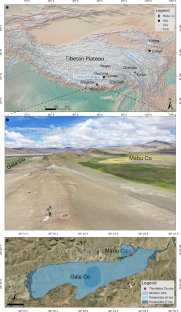Lake-centred sedentary lifestyle of early Tibetan Plateau Indigenous populations at high elevation 4,400 years ago
IF 13.9
1区 生物学
Q1 ECOLOGY
引用次数: 0
Abstract
The onset of sedentism on the Tibetan Plateau is often presumed to be associated with the dispersal of agriculture or farmers from archaeological sites located in the low elevation margins of the plateau. Previous studies of the plateau assumed that all foragers were probably mobile, but few systematic excavations at forager sites have been conducted to inform us about their settlement patterns. Here we report the world’s highest elevation sedentary way of living exhibited by the Mabu Co site at 4,446 metres above sea level, deep in the interior of the Tibetan Plateau 4,400–4,000 years ago. Our interdisciplinary study indicates that the site was occupied by Indigenous inhabitants of the plateau, representing the earliest known DNA evidence of foragers who predominantly harbour the southern plateau ancestry. The evidence shows that they had a sedentary lifestyle primarily supported by fishing at nearby lakes, supplemented by mammal and bird hunting, as well as small-scale exchanges of millet and rice crops. Ancient DNA, stable isotopes and other archaeological methods establish that humans were living at extremely high elevation on the Tibetan Plateau 4,400 years ago, maintaining sedentary lifestyles that combined fishing, hunting and crop exchange.


4400 年前青藏高原高海拔地区早期土著居民以湖泊为中心的定居生活方式
人们通常认为,青藏高原定居现象的出现与位于高原低海拔边缘的考古遗址中农业或农民的扩散有关。以前对高原的研究假设所有觅食者都可能是流动的,但很少对觅食者遗址进行系统发掘,以了解他们的定居模式。在此,我们报告了世界上海拔最高的定居生活方式,即海拔 4446 米的马布错遗址,该遗址位于青藏高原内陆深处,距今 4400-4000 年。我们的跨学科研究表明,该遗址被高原原住民占据,是已知最早的觅食者 DNA 证据,他们主要拥有南部高原的血统。证据显示,他们过着定居的生活方式,主要靠在附近湖泊捕鱼为生,并以狩猎哺乳动物和鸟类以及小规模交换小米和水稻作物为辅。
本文章由计算机程序翻译,如有差异,请以英文原文为准。
求助全文
约1分钟内获得全文
求助全文
来源期刊

Nature ecology & evolution
Agricultural and Biological Sciences-Ecology, Evolution, Behavior and Systematics
CiteScore
22.20
自引率
2.40%
发文量
282
期刊介绍:
Nature Ecology & Evolution is interested in the full spectrum of ecological and evolutionary biology, encompassing approaches at the molecular, organismal, population, community and ecosystem levels, as well as relevant parts of the social sciences. Nature Ecology & Evolution provides a place where all researchers and policymakers interested in all aspects of life's diversity can come together to learn about the most accomplished and significant advances in the field and to discuss topical issues. An online-only monthly journal, our broad scope ensures that the research published reaches the widest possible audience of scientists.
 求助内容:
求助内容: 应助结果提醒方式:
应助结果提醒方式:


